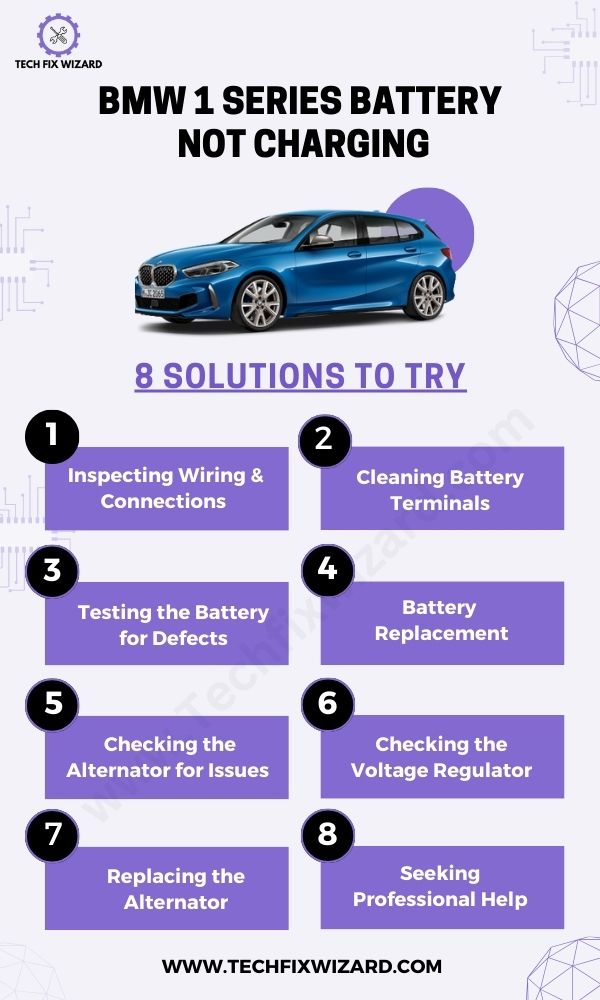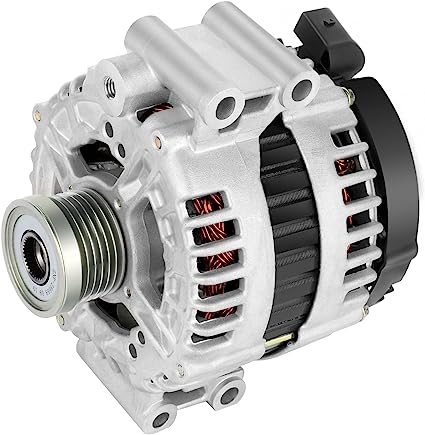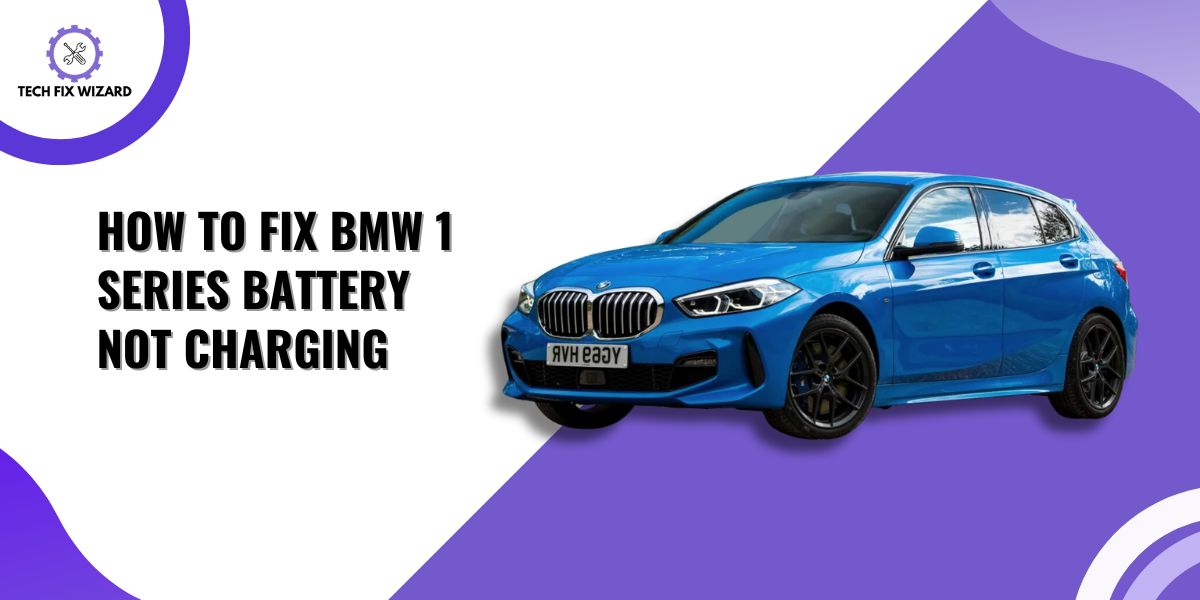Encountering the BMW 1 Series battery not charging issue can be frustrating and inconvenient.
A properly functioning battery is essential for powering the vehicle’s electrical systems and starting the engine reliably.
In this article, we will explore the potential causes of a BMW 1 Series battery not charging issue and provide you with step-by-step troubleshooting methods to help diagnose and resolve the problem.
Contents
- 1 BMW 1 Series Battery Not Charging – 8 Common Symptoms
- 2 Troubleshooting BMW 1 Series Battery Not Charging
- 3 1. Inspecting Wiring and Connections for Damage
- 4 2. Cleaning Battery Terminals and Connections
- 5 3. Testing the Battery for Defects
- 6 4. Battery Replacement
- 7 5. Checking the Alternator for Issues
- 8 6. Checking the Voltage Regulator
- 9 7. Replacing the Alternator
- 10 8. Seeking Professional Help
- 11 Conducting Regular Maintenance to Prevent Future Issues
- 12 FAQs
- 13 Why is my BMW 1 Series battery not charging?
- 14 How can I tell if my BMW 1 Series battery is not charging?
- 15 What should I do if my BMW 1 Series battery is not charging?
- 16 Can a faulty alternator cause the BMW 1 Series battery not to charge?
- 17 How long does it take to charge a BMW 1 Series battery?
- 18 Can a jump-start solve the BMW 1 Series battery not charging issue?
- 19 What is the average lifespan of a BMW 1 Series battery?
- 20 How much does it cost to replace the battery in a BMW 1 Series?
- 21 Can I replace the battery in my BMW 1 Series myself?
- 22 Can a software issue cause the BMW 1 Series battery not to charge?
- 23 Will a new battery automatically solve the BMW 1 Series battery not charging problem?
- 24 How can I prevent my BMW 1 Series battery from not charging in the future?
- 25 Official References & Resources
BMW 1 Series Battery Not Charging – 8 Common Symptoms
Before diving into the troubleshooting of the BMW 1 series battery not charging issue, it’s important to identify the symptoms to accurately diagnose the problem.
By recognizing the signs of a battery not charging, you can take the necessary steps to resolve the issue effectively.
Here are some common symptoms to look out for:
| No. | Symptoms | Description |
|---|---|---|
| 1. | Battery Warning Light | The battery warning light on the dashboard illuminates, indicating a problem with the battery charging system. |
| 2. | Difficulty Starting or Slow Engine Crank | You may experience difficulty starting the car, requiring multiple attempts or a longer cranking time for the engine to start. |
| 3. | Clicking Noise When Starting | When attempting to start the vehicle, you may hear a clicking noise instead of the engine turning over.
This can be an indication of a low battery charge or a problem with the starter motor. |
| 4. | Dimming or Flickering Lights | Lights, both interior and exterior, may appear dim or flicker while the vehicle is running.
This can include headlights, dashboard lights, and interior cabin lights. |
| 5. | Loss of Electrical Power to Components | Electrical components in the car, such as power windows, infotainment system, radio, or climate control, may not function properly or experience intermittent failures. |
| 6. | Warning Messages on the Dashboard | The onboard computer system may display warning messages or symbols related to the battery or charging system.
These messages can vary but commonly indicate a charging system malfunction or low battery voltage. |
| 7. | Unusual Battery Drain or Shortened Battery Life | If the battery is not charging properly, you may notice a faster rate of battery drain or a shortened overall battery life. |
| 8. | Electrical System Malfunctions or Erratic Behavior | The vehicle’s electrical system may exhibit malfunctions or behave erratically, such as random warning lights, unpredictable gauge readings, or intermittent power interruptions. |
Troubleshooting BMW 1 Series Battery Not Charging
If you have experienced any of the above symptoms, likely, that your battery isn’t charging.
Now let’s proceed with troubleshooting the BMW 1 Series battery not charging issue.
1. Inspecting Wiring and Connections for Damage
The first step in troubleshooting the BMW 1 Series battery not charging issue is to inspect the wiring and connections for any signs of damage.
Here’s how you can do it:
- Open the Hood: Pop the hood of your BMW 1 Series and secure it properly.
- Locate the Battery: Identify the location of the battery in the engine bay. It is typically located on one side, near the front of the vehicle.
- Visual Inspection: Carefully examine the battery terminals, cables, and associated wiring for any visible signs of damage. Look for frayed or cracked insulation, loose connections, or corrosion on the terminals.
- Tighten Loose Connections: If you find any loose connections, use a wrench or pliers to tighten them securely. Ensure that the connections are snug but not overly tightened.
- Clean Corroded Terminals: If corrosion is present on the battery terminals, use a wire brush or battery terminal cleaner to remove the buildup. Make sure to clean both the terminal posts and cable clamps thoroughly.
- Inspect Wiring Harnesses: Trace the wiring harnesses connected to the battery and follow them to their respective destinations. Pay attention to any wiring near the alternator or charging system components.
- Repair or Replace Damaged Wiring: If you identify any damaged wiring or connectors, it may be necessary to repair or replace them.
- Reconnect and Secure: After inspecting and repairing any wiring or connection issues, reconnect the battery terminals securely. Double-check that all connections are tight and properly seated.
- Test Charging System: Start the vehicle and observe if the battery warning light on the dashboard is still illuminated.

Also Read: BMW 3 Series Battery Not Charging – 7 Solutions You Can Try
2. Cleaning Battery Terminals and Connections
The second step in troubleshooting the BMW 1 Series battery not charging issue is to clean the battery terminals and connections.
Over time, corrosion and dirt can accumulate on the battery terminals and hinder proper electrical contact, leading to charging problems.

Follow these steps to clean the battery terminals and connections:
1. Disconnect the Battery:
Start by disconnecting the negative terminal (marked with a “-” sign) followed by the positive terminal (marked with a “+” sign).
Loosen the terminal clamps using a wrench or pliers and carefully remove them from the battery posts.
2. Inspect the Terminals:
Examine the battery terminals for signs of corrosion, which appear as a white or greenish powdery substance. If present, it needs to be removed for optimal electrical contact.
3. Prepare a Cleaning Solution:
Mix a solution of baking soda and water in a small container. Stir until the baking soda is fully dissolved.
This solution helps neutralize and remove the corrosion on the terminals.
4. Clean the Terminals:
Dip an old toothbrush or a battery terminal cleaning brush into the baking soda solution. Gently scrub the terminals to remove the corrosion buildup.
Pay attention to both the terminal posts and the inside of the terminal clamps.
5. Rinse with Water:
After scrubbing, rinse the terminals with clean water to wash away the baking soda solution and any loosened corrosion. Use a spray bottle or a damp cloth to ensure thorough rinsing.
6. Dry and Reconnect:
Once the terminals are clean and dry, reconnect them to the battery posts. Start by connecting the positive terminal first (marked with a “+”), followed by the negative terminal (marked with a “-“).
Tighten the terminal clamps securely with a wrench or pliers.
7. Test Charging System:
Start the vehicle and check if the battery warning light on the dashboard is still illuminated.
You May Also Like: BMW 5 Series Battery Not Charging – 7 Solutions To Try
3. Testing the Battery for Defects
The next crucial step in troubleshooting the BMW 1 Series battery not charging issue is to test the battery for any defects. The battery serves as the main component of the charging system, and its health directly impacts the charging process.
Here’s how you can test the battery:
| Step | Procedure | Description |
|---|---|---|
| 1. | Safety Precautions | Ensure the vehicle is turned off, and wear protective gloves and safety glasses. |
| 2. | Access the Battery | Locate the battery in the engine bay or trunk of your BMW 1 Series. |
| 3. | Check Battery Voltage | Use a multimeter to measure the voltage across the battery terminals. |
| 4. | Compare Voltage with Specifications | Consult the owner’s manual or manufacturer for the recommended voltage range. |
| 5. | Load Testing | Perform a load test to assess the battery’s ability to deliver power under a simulated load. |
| 6. | Interpreting Load Test Results | Interpret the load test results to determine if the battery is in good condition or requires replacement. |
| 7. | Consider Battery Age | Take into account the age of the battery and its expected lifespan when assessing its condition. |
| 8. | Battery Replacement | If the battery fails the load test or is beyond its expected lifespan, consider replacing it with a new one. |
4. Battery Replacement
Follow the steps below for replacing the battery:
- Locate the Battery: Find the battery in the engine bay or trunk.
- Prepare Tools: Gather a wrench or pliers for the replacement.
- Disconnect the Battery: Remove the negative terminal first, followed by the positive terminal.
- Remove the Old Battery: Take out the old battery after releasing any securing brackets or clamps.
- Clean Battery Tray: Ensure the battery tray is clean and free of dirt, debris, and corrosion.
- Install the New Battery: Place the new battery securely in the battery compartment.
- Reconnect the Battery: Attach the positive terminal first, then the negative terminal.
- Test and Verify: Start the vehicle and check for the absence of the battery warning light.
5. Checking the Alternator for Issues
After addressing the battery-related causes of the BMW 1 Series battery not charging issue, the next step is to check the alternator for potential issues.
The alternator is responsible for generating electrical power to recharge the battery while the engine is running.

Here’s how you can check the alternator:
- Locate the Alternator: Find it near the front of the engine, connected to the crankshaft with a belt.
- Inspect the Belt: Check for damage, such as cracks or excessive slack.
- Check Connections: Ensure electrical connections are clean, secure, and free from corrosion.
- Test Charging Voltage: Start the engine, and measure the voltage across the battery terminals.
- Check Voltage Reading: The normal range is around 13.8 to 14.4 volts.
- Load Testing: Perform a load test to assess the alternator’s performance.
- Professional Inspection: Seek professional assistance if needed.
Similar Read: BMW 7 Series Battery Not Charging – 6 Troubleshooting Steps
6. Checking the Voltage Regulator
Checking the voltage regulator is another important step in troubleshooting the BMW 1 Series battery not charging issue.
The voltage regulator is responsible for regulating the electrical output of the alternator and ensuring that the battery receives the appropriate charging voltage.

If the voltage regulator malfunctions, it can result in overcharging or undercharging of the battery, leading to battery-related issues. Here are the steps to check the voltage regulator:
- Locate the Voltage Regulator: Find it integrated into the alternator or nearby.
- Visual Inspection: Check for visible damage, such as burnt components or loose connections.
- Testing with a Multimeter: Start the engine, and set the multimeter to DC voltage mode. Connect the probes: positive (red) to the positive battery terminal, and negative (black) to a metal ground point.
- Voltage Measurement: Measure the voltage across the battery terminals while the engine is running. Normal range: around 13.8 to 14.4 volts.
7. Replacing the Alternator
Replacing the alternator is an involved process and should be done with caution. It is recommended to have a professional mechanic perform this task.
However, if you have the necessary skills and tools, here is the outline of the steps involved in replacing the alternator in the BMW 1 Series:
Ensure the vehicle is turned off and parked in a safe location. Put on safety gloves and eye protection before replacing the alternator.
Also, locate the battery in your vehicle and disconnect the negative (-) terminal first, followed by the positive (+) terminal. This step is important to prevent any electrical mishaps during the alternator replacement.
The alternator is typically located near the engine. Refer to your vehicle’s manual or consult a repair guide specific to your BMW 1 Series model for the exact location.
After locating the alternator follow the steps below:
- Disconnect electrical connections: Identify and disconnect all electrical connections attached to the alternator. These may include wiring harnesses, plugs, and connectors. Take note of their positions or take pictures for reference during reassembly.
- Loosen the drive belt: Using a wrench or a belt tensioner tool, loosen the tension on the drive belt connected to the alternator. This will allow you to remove the belt from the alternator pulley.
- Remove mounting bolts: Locate and remove the mounting bolts that secure the alternator to the engine or bracket.
- Detach the alternator: Carefully lift and detach the alternator from its mounting position.
- Compare the new alternator: Compare the new alternator with the old one to ensure they match in terms of specifications and mounting points.
- Install the new alternator: Install the new alternator in the reverse order of removal, securing it with the mounting bolts.
- Reconnect electrical connections: Attach the electrical connections to the new alternator, ensuring they are properly connected and secured.
- Tighten the drive belt: Use a wrench or belt tensioner tool to apply tension to the drive belt and ensure it is properly aligned on the alternator pulley.
- Reconnect the battery: Reconnect the positive (+) terminal first, followed by the negative (-) terminal.
- Test and verify: Start the engine and test the new alternator for proper operation.
8. Seeking Professional Help
If you have followed all the steps to diagnose and resolve the battery charging issue in your BMW 1 Series but the problem persists, it is advisable to seek professional help.
A qualified technician or a BMW dealership will have the expertise and specialized equipment to accurately diagnose and address complex electrical issues.
They can perform advanced diagnostic tests to identify the root cause of the problem and recommend the appropriate repairs or replacements.
Our Popular Posts:
- BMW Wireless Not Charging – 9 Causes And Easy Fixes
- BMW Wallbox Not Charging – 6 Effective Solutions To Try
- BMW Not Charging iPhone – 7 Quick & Easy Solutions
Conducting Regular Maintenance to Prevent Future Issues
To prevent future issues with your BMW 1 Series battery not charging, follow these maintenance tips below:
- Inspect battery connections: Regularly check for corrosion and ensure secure connections.
- Monitor battery health: Keep an eye on voltage levels and replace a weakening battery promptly.
- Test the charging system: Periodically have the charging system tested for proper functioning.
- Minimize electrical usage: Avoid excessive use of accessories when the engine is off.
- Drive regularly: Drive regularly or prevent battery discharge during inactivity, use a battery maintainer or trickle charger for infrequently used vehicles.
- Look for warning signs: Be attentive to warning lights, dimming headlights, or engine starting issues.
- Protect from extreme temperatures: Park in sheltered areas and use insulation kits when needed.
- Follow maintenance schedules: Adhere to recommended servicing intervals for timely issue detection.
- Consult professionals: Seek assistance from qualified technicians or BMW dealerships for guidance.
FAQs
Why is my BMW 1 Series battery not charging?
There could be several reasons for this, such as a faulty alternator, a defective battery, a loose or corroded connection, or a malfunctioning charging system.
How can I tell if my BMW 1 Series battery is not charging?
Look for signs like dimming headlights, a slow cranking engine, the battery warning light illuminating on the dashboard, or a completely dead battery.
What should I do if my BMW 1 Series battery is not charging?
Start by checking the battery connections for any signs of damage or corrosion. If they appear fine, have the battery and charging system tested by a qualified technician.
Can a faulty alternator cause the BMW 1 Series battery not to charge?
Yes, a malfunctioning alternator can fail to provide sufficient power to charge the battery, leading to a drained or discharged battery.
How long does it take to charge a BMW 1 Series battery?
The charging time can vary depending on the battery’s state of charge, the charger’s capacity, and the condition of the battery. Generally, it can take several hours to fully charge a depleted battery.
Can a jump-start solve the BMW 1 Series battery not charging issue?
Jump-starting the car can provide temporary power to start the engine, but it won’t address the underlying charging problem. It’s crucial to diagnose and fix the charging system issue.
What is the average lifespan of a BMW 1 Series battery?
The lifespan of a car battery varies, but typically it can last anywhere between three to six years. However, several factors, such as climate and driving conditions, can influence its longevity.
How much does it cost to replace the battery in a BMW 1 Series?
The cost of a replacement battery for a BMW 1 Series can vary depending on the battery type, brand, and where you purchase it. On average, it can range from $150 to $300.
Can I replace the battery in my BMW 1 Series myself?
While it is possible to replace the battery yourself, it is recommended to have it done by a professional technician who has the necessary tools and expertise to ensure proper installation.
Can a software issue cause the BMW 1 Series battery not to charge?
In rare cases, a software glitch or a faulty control module can affect the charging system’s operation. Consulting a BMW dealership or qualified technician can help diagnose such issues.
Will a new battery automatically solve the BMW 1 Series battery not charging problem?
Not necessarily. While a new battery can help if the old one is faulty, it’s crucial to ensure that the underlying charging system issue is addressed to prevent future battery problems.
How can I prevent my BMW 1 Series battery from not charging in the future?
Regular maintenance, including inspecting and cleaning battery connections, monitoring the charging system, and addressing any issues promptly, can help prevent charging problems in the future.
People Also Liked:
- BMW Not Charging Phone – 6 Quick Fixes
- BMW Bluetooth Not Working – Quick Fixes
- BMW Cigarette Lighter Not Charging – 4 Causes & 6 Step Solution
Official References & Resources
Our research for providing accurate information about BMW involved a thorough analysis of official resources, including the official BMW website owner’s manuals, technical specifications, and relevant support forums.
Our research and data gathering involved thorough analysis of the official websites, including:

John Paul is a tech enthusiast dedicated to troubleshooting. He is passionate about fixing glitches, simplifying complexities, and empowering others in the digital realm.

